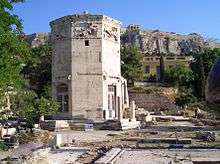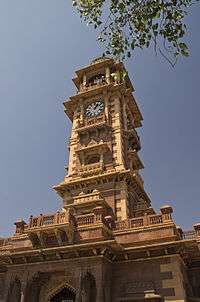Clock tower
Clock towers are a specific type of building which houses a turret clock and has one or more clock faces on the upper exterior walls. Many clock towers are freestanding structures but they can also adjoin or be located on top of another building.
Clock towers are a common sight in many parts of the world with some being iconic buildings. One example is the Elizabeth Tower in London (sometimes erroneously called 'Big Ben', although this name belongs only to the bell inside the tower).
Definition
There are many structures which may have clocks or clock faces attached to them and some structures have had clocks added to an existing structure. According to the Council on Tall Buildings and Urban Habitat a building is defined as a building if at least fifty percent of its height is made up of floor plates containing habitable floor area. Structures that do not meet this criterion, are defined as towers. A clock tower historically fits this definition of a tower and therefore can be defined as any tower specifically built with one or more (often four) clock faces and that can be either freestanding or part of a church or municipal building such as a town hall. Not all clocks on buildings therefore make the building into a clock tower.
The mechanism inside the tower is known as a turret clock. It often marks the hour (and sometimes segments of an hour) by sounding large bells or chimes, sometimes playing simple musical phrases or tunes.
History

Although clock towers are today mostly admired for their aesthetics, they once served an important purpose. Before the middle of the twentieth century, most people did not have watches, and prior to the 18th century even home clocks were rare. The first clocks didn't have faces, but were solely striking clocks, which sounded bells to call the surrounding community to work or to prayer. They were therefore placed in towers so the bells would be audible for a long distance. Clock towers were placed near the centres of towns and were often the tallest structures there. As clock towers became more common, the designers realized that a dial on the outside of the tower would allow the townspeople to read the time whenever they wanted.

The use of clock towers dates back to the antiquity. The earliest clock tower was the Tower of the Winds in Athens which featured eight sundials. In its interior, there was also a water clock (or clepsydra), driven by water coming down from the Acropolis.[1] In Song China, an astronomical clock tower was designed by Su Song and erected at Kaifeng in 1088, featuring a liquid escapement mechanism. In England, a clock was put up in a clock tower, the medieval precursor to Big Ben, at Westminster, in 1288;[2][3] and in 1292 a clock was put up in Canterbury Cathedral.[2] The oldest surviving turret clock formerly part of a clock tower in Europe is the Salisbury cathedral clock, completed in 1306; and another clock put up at St. Albans, in 1326, 'showed various astronomical phenomena'.[2]
Al-Jazari constructed an elaborate clock and described it in his Book of Knowledge of Ingenious Mechanical Devices in 1206. It was about 3.3 metres (11 feet) high, and had multiple functions alongside timekeeping. It included a display of the zodiac and the solar and lunar paths, and a pointer in the shape of the crescent moon which travelled across the top of a gateway, moved by a hidden cart and causing automatic doors to open, each revealing a mannequin, every hour.[4][5] It was possible to re-program the length of day and night daily in order to account for the changing lengths of day and night throughout the year, and it also featured five robotic musicians who automatically play music when moved by levers operated by a hidden camshaft attached to a water wheel. Other components of the castle clock included a main reservoir with a float, a float chamber and flow regulator, plate and valve trough, two pulleys, crescent disc displaying the zodiac, and two falcon automata dropping balls into vases.[6]
Line (mains) synchronous tower clocks were introduced in the United States in the 1920s.
Landmarks

Some clock towers have become famous landmarks. Some examples are Elizabeth Tower built in 1859, which houses the Great Bell (generally known as Big Ben) in London, the tower of Philadelphia City Hall, the Rajabai Tower in Mumbai, the Spasskaya Tower of the Moscow Kremlin, the Torre dell'Orologio in the Piazza San Marco in Venice, Italy, and Zytglogge clock tower in the Old city of Bern, Switzerland.[7]
Records

The Allen-Bradley Clock Tower in Milwaukee, Wisconsin has the largest four faced (non-chiming) clock in the world, with clock diameter 40 ft 3 1⁄2 in (12.281 m); it is 283 ft (86 m) tall. The Elizabeth Tower has the largest chiming clock in the world; it is 315 feet (96 m) tall.
The tallest freestanding clock tower in the world is the Joseph Chamberlain Memorial Clock Tower at the University of Birmingham in the United Kingdom.[8] The tower stands at 100 metres (330 feet) tall and was completed in 1908. The clock tower of Philadelphia City Hall was the tallest building in the world from 1901 to 1908.
There are taller buildings which have had clocks faces added to an exiting structure such as Palace of Culture and Science with a clock added in 2000 (roof height: 187.68 m (615.7 ft), with antenna: 231 m (758 ft)), NTT DoCoMo Yoyogi Building with a clock added in 2002 (roof height: 240 meters (790 ft), with antenna: 272 meters (892 ft)). The Abraj Al Bait, constructed in 2012 is a building with the largest clock face in the world (roof top: 530 m (1,740 ft), with tip: 601 metres (1,972 ft)). However it is not, by definition, a clock tower as it is a hotel.
See also
- List of clock towers
- Turret clock, the mechanism used in most clock towers
- Bell tower
- Minaret
- Thirteenth stroke of the clock
- Street clock
References
- ↑ Joseph V. Noble; Derek J. de Solla Price: The Water Clock in the Tower of the Winds, American Journal of Archaeology, Vol. 72, No. 4 (1968), pp. 345-355 (353)
- 1 2 3 Clocks, Encyclopaedia Britannica 5, 835 (1951).
- ↑ Frederick Tupper, Jr., 'Anglo-Saxon Dæg-Mæl', Publications of the Modern Language Association of America, Vol. 10, No. 2 (1895), p. 130, citing Archæologia, v, 416.
- ↑ Howard R. Turner (1997), Science in Medieval Islam: An Illustrated Introduction, p. 184. University of Texas Press, ISBN 0-292-78149-0.
- ↑ Donald Routledge Hill, "Mechanical Engineering in the Medieval Near East", Scientific American, May 1991, p. 64-69. (cf. Donald Routledge Hill, Mechanical Engineering Archived December 25, 2007, at the Wayback Machine.)
- ↑ Salim Al-Hassani (13 March 2008). "How it Works: Mechanism of the Castle Clock". FSTC. Retrieved 2008-09-06.
- ↑ "UK Parliament - Big Ben". Retrieved 2009-10-27.
- ↑ "Joseph Chamberlain Memorial Clock Tower". Skyscraper News. Retrieved 15 April 2014.
External links
| Wikimedia Commons has media related to Clock towers. |
- Towerclocks.org - Tower clocks database
- Railway Station Clock Towers Architecture of time